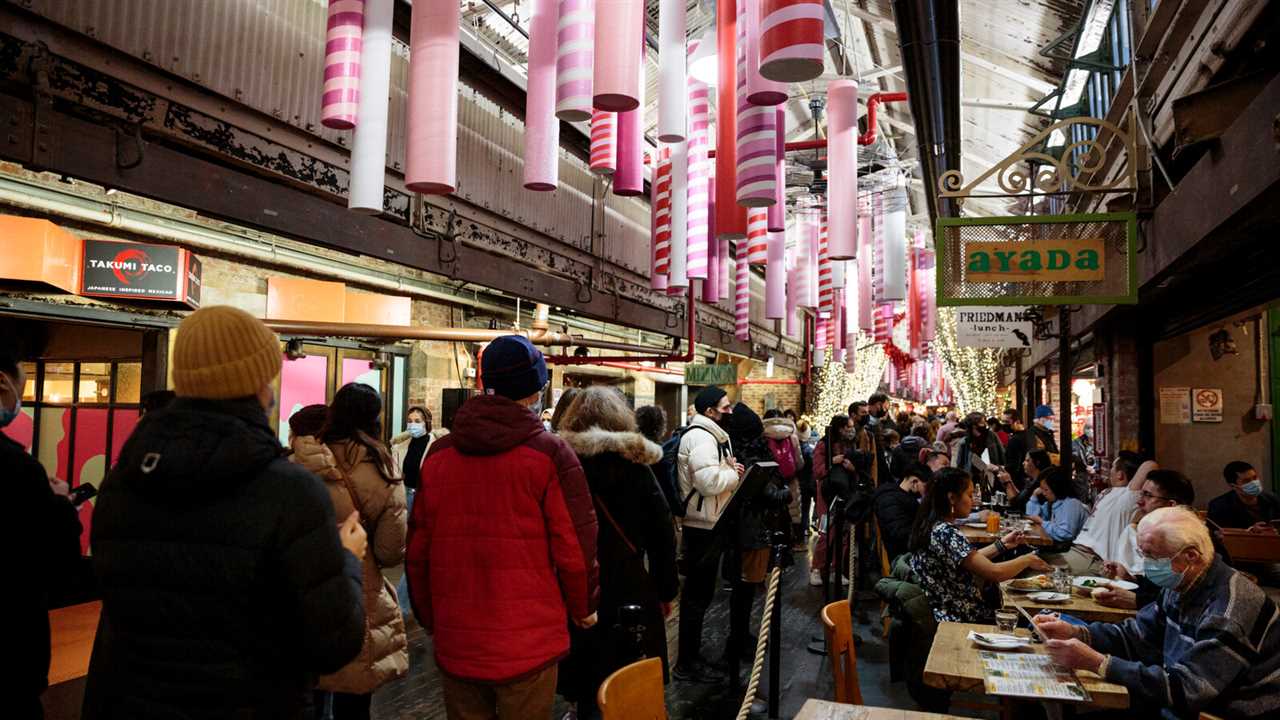
Not long after graduating from the University of Florida this spring, Emily Locke decided to move to the Chelsea neighborhood in Manhattan.
Ms. Locke, 22, grew up near West Palm Beach, but had long been attracted to the invigorating, unpredictable energy she felt during childhood visits to New York. Chelsea offered the perfect blend of shops and access to multiple subway lines.
She knew of the pandemic’s devastating toll in New York and how so many people had fled the city. Still, this summer she jumped at the chance to rent a studio apartment. Fully vaccinated, she has gone to Broadway shows and restaurants close to home, and even has a favorite neighborhood juice shop.
As the pandemic gave rise to scenes of death and desperation across New York, few places emptied out more than the blocks in and around Chelsea, the upscale neighborhood known for trendy restaurants, art galleries and an elevated urban park, the High Line. The outflow of residents from Manhattan fueled headlines about New York’s demise and the decline of urban America.
But even as the Omicron variant has once again plunged the city into uncertainty, this year has also fostered a more hopeful narrative: the filling out of once-emptied neighborhoods. Chelsea has been among the leading areas in New York in luring returning and new residents, new findings show, stoking a boom in the housing market and projecting a far more optimistic future than the one conjured by last year’s gloomiest predictions. Asking rents have skyrocketed and surpassed prepandemic levels.
“Covid is terrible, and what it’s doing to the city is horrible,” said Ms. Locke, who works at a marketing firm in Manhattan. “But you can’t let it completely stop you from living your life.”
Ms. Locke, who tested positive this month and has since recovered, said she understood the toll the Omicron variant was taking on the city, but that she was not scared, noting that vaccines seemed to be preventing the worst outcomes for many people.
“It has to end at some point,” she said.
Chelsea is one of several Manhattan neighborhoods, including Murray Hill, the East Village, the Upper East Side and Greenwich Village, where a rapid exodus driven by the pandemic appears to have largely stopped, and is even slowly reversing in some cases. In one ZIP code in Chelsea, for example, data from the United States Postal Service shows more people moving in than out during several months of this year.
The population is still far from fully recovered and remote work is enabling many employees to live far from their Manhattan offices. The Omicron variant is feeding a resurgent wave of infections and anxiety, raising questions about how much longer office workers and tourists will stay away from New York and hobble its recovery.
Learn More About N.Y.C. Skyscrapers
- Testing the Limits: Only three of New York’s 25 tallest residential buildings have completed safety tasks required by the city.
- The Downside to Life in a Supertall: 432 Park faces some significant design problems, and other luxury high-rises may share its fate.
- Luxury Developers’ Loophole: Soaring towers are able to push high into the sky because of a loophole in the city’s labyrinthine zoning laws.
- An Evolving Skyline: The high-rise building boom has transformed the city’s skyline in recent years. Its impact will echo for years to come.
- Hidden Feats: Our critic looks at some supertall N.Y.C. buildings and how the ingenuity of engineers helped build landmarks.
And for many working-class parts of the city, the picture is more dire: unemployment remains high, thousands struggle to pay rent, and the expiration of New York’s moratorium on evictions looms just weeks away.
But the resurgence in Chelsea reflects how many of the city’s wealthier neighborhoods, which hollowed out as the pandemic began last year, are now slowly rebounding and showing the potential for a vibrant future anchored in what has long made New York attractive and resilient: an abundance of culture, entertainment and social attractions.
“People want to be at the center of the action,” said Kathryn Wylde, the president of the Partnership for New York City, an influential business organization. “Work is one piece of that, but there’s much more. They want to be where the ball drops on New Year’s Eve. They want to be where the art shows open, where fashion is defined, where there are limitless cultural opportunities.”
The pandemic prompted many to abandon cities across the country for suburbs or rural areas. But the outflow appears to be slowing in many urban centers, as more people have gotten vaccinated and schools and businesses have reopened.
And the population shifts have been the most striking in the nation’s largest city, which was among the first and hardest-hit places in the early days of the pandemic.
A recent analysis of United States Postal Service data by the New York City Comptroller found that the number of residents leaving the city in 2020 was triple that in 2019. The outflow has also underscored the city’s inequality: residents in the wealthiest neighborhoods, many who have white-collar jobs that made remote work easier or had resources to move, were much more likely to have left than other residents, the report found.
This year, a swath of western Manhattan, including Chelsea and Midtown, which saw among the greatest losses in 2020, also saw among the greatest net gain of people who said they planned to stay permanently, the report found.
The Postal Service data, which tracks address changes reported by residents, is incomplete — for example, it does not account for international migration nor does it capture young adults making a first move after college who may not fill out change of address forms.
A separate analysis by the Partnership for New York City, examining just one ZIP code in Chelsea, and looking at both permanent and temporary moves, showed a net loss in 2020 of more than 2,700 residents, amounting to about 12 percent of the estimated population of the entire ZIP code — among the highest proportions of people leaving any ZIP code in the city.
The data reflects a brighter picture this year: The net loss through November was about 100. And between April and November, there was even a net gain of 29. That is a notable reversal compared with the corresponding period in 2019, when the ZIP code showed a net loss of more than 530.
“I feel like Chelsea is reviving from the pandemic,” said Michael J. Franco, a real estate agent with the brokerage Compass who works in the neighborhood.
Mr. Franco said apartment sales have started picking up. In one building in the heart of Chelsea, 15 apartments have sold in 2021, compared with three in 2020, he said.
Rents have been soaring. According to StreetEasy, the median asking rent in November in Chelsea was $4,801, up more than 45 percent over the prior year, and higher than a $4,462 peak in June 2019.
The rising housing prices are driven, in part, by many people who postponed moving and saved up money during the pandemic, brokers and analysts said. Other property owners had taken units off the market because they knew they might not get a good price. Low mortgage rates are encouraging more buying.
“When you have a massive surge in sales activity, part of that is pent-up demand, part of that is extreme confidence about the future, and part of it is normalizing,” said Jonathan Miller of Miller Samuel, an appraisal company. “The city has been playing catch-up from the lack of activity.”
Still, Mark Zandi, chief economist at Moody’s Analytics, said New York faced immense challenges.
While the return of some residents may buoy particular neighborhoods, he said that overall, the New York City metropolitan area, including Newark and Jersey City, N.J., is still losing population, just at a slower rate.
“I don’t think anyone is arguing that New York won’t come back,” Mr. Zandi said, adding that the questions will be “how quickly, and will it ever get back what it lost during the pandemic.”
Chelsea is drawing both newcomers and residents who left and have come back.
As the pandemic worsened in April 2020, Emily Bracken, 45, moved from her apartment in Harlem to her sister’s home in Westchester County. Ms. Bracken enjoyed reconnecting with family. But after a few months, she began missing the small things about life in New York, like interactions at the bodega or overhearing strangers’ conversations.
Ms. Bracken had always wanted to buy a place in the city and found a one-bedroom in Chelsea, which she was attracted to because of how easy it was to get to Brooklyn or Greenwich Village, NoMad and other neighborhoods she liked. She declined to give the exact price, but said the apartment fell within her price range of $500,000 to $1 million. The deal closed in September and she moved in around Thanksgiving.
“I liked the idea of doubling down on New York,” she said.
Yousif Alrasheed, 25, a graduate student at Pace University who is studying remotely, moved in May to a one-bedroom apartment in Chelsea from Boston, where he was living near family. Mr. Alrasheed grew up in Kuwait, and had visited New York City many times in the past. He never considered living anywhere else.
“Coming to the city was amazing compared to Boston,” he said. “It was so lively here.”
Mr. Alrasheed said he loves Chelsea’s central location and the concentration of nearby bars and restaurants. Among the biggest draws of the apartment, which costs about $3,600 a month: a washer and dryer and a walk-in closet. And he has recently noticed more and more people in the neighborhood.
“Especially when the fall started and summer ended, everyone just came back here,” he said.
Justin Silver, who had lived in Chelsea for 25 years, moved last winter to Los Angeles, where he was able to stay with friends for free. Mr. Silver, who performs stand-up comedy, enjoyed the weather and the ease of social distancing.
As vaccines became increasingly available, however, Mr. Silver, 45, moved back to his rent-regulated unit in the neighborhood — an affordable place to stay in a pricey Manhattan neighborhood.
“The ease of just being on this island, it just makes it so much easier to get around,” he said.
Nate Schweber contributed reporting.
Title: ‘Doubling Down on New York’: A Manhattan Neighborhood Bounces Back
Sourced From: www.nytimes.com/2021/12/29/nyregion/chelsea-nyc-coronavirus.html
Published Date: Wed, 29 Dec 2021 10:00:14 +0000
Did you miss our previous article...
https://rsssuperfeeds.com/viral-news/russian-court-orders-prominent-human-rights-group-to-shut-down






